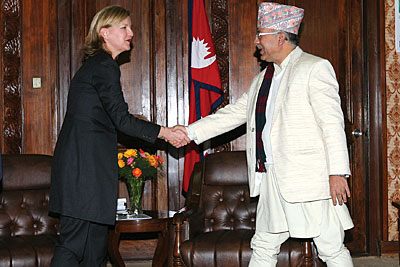 KIRAN PANDAY |
Don't fall for the simplistic and deceitful government propaganda of 'UNMIN is not co-operating with us'. The issue is a lot more complex, involving Nepal's requests to the Security Council, peace agreements, inter-party divisions, the UML-NC combine's shifting goalposts, and Maoist mischief.
The government wants to know how many people are present in cantonments, though it has never asked UNMIN officially to count the numbers. A second though not necessarily related aspect is the government's formal request for combatant data (name, gender, date of birth, photograph, and address).
Based on the fact that only 2400 out of 4000 disqualified combatants were present during the discharge, Madhav Nepal claims 60 per cent of the verified combatants (around 11,500) remain in the cantonments. Privately, Maoist leaders admit that the numbers have dipped but say it is closer to the 16-17,000 mark. Add to this the widespread belief that a part of the money meant for the former combatants goes to the party.
Is the government right in demanding to know who it is paying and how much? Absolutely.
The problem is they are asking in the wrong places. The Ministry of Peace and Reconstruction pays the verified combatants on the basis of identity cards and barcodes. If the government feels not everyone is in the camps, who has it been paying all this while? Have 'fake' combatants using 'fake' ids been taking money? If so, what does it say about the bureaucrats responsible?
Even if we were to give credit to the government for waking up to the issue now, the point is the PLA remains under the Maoists. If anyone can answer how many are present in the cantonments, it is the Maoist party. And they must be pressurised to do so.
UNMIN is not responsible for the management of either of the two armies. With 73 arms monitors, it is at best monitoring the management of these armies through regular visits to the NA barracks and PLA cantonments, with an eye on the arms containers. It has been regularly informing the Joint Monitoring Coordination Committee (JMCC) about its findings and concerns.
If UNMIN has not alerted us to a mass exodus from the cantonments despite knowing about it, then it has to be held accountable. But UNMIN says it doesn't know how many people are there. In fact, it has continued to ask the Maoists (and the NA) to provide updated figures on troop strength, which is the maximum the Agreement on the Monitoring of the Management of Arms and Armies (AMMAA) allows it to do. The perception is that UNMIN should know the numbers. But the reality is that the government or JMCC or the Special Committee never requested them to do a fresh count, an elaborate exercise requiring time and resources.
On the data, UNMIN's case is even stronger. Paragraph 2 of the AMMAA says, "The parties will report detailed information about their troops and this information will be treated with appropriate confidentiality by the United Nations."
The government is acting all righteous and pretending it is an affront to sovereignty that UNMIN is not providing the information it has requested. What is forgotten is that the government is only one part of the peace process. The NC-UML combine should have thought twice before allowing the Maoist army to be given equal status with the NA when they were signing the AMMAA. If the government can ask for data about the Maoist army, the Maoists can ask UNMIN to give them data on the Nepal Army. Surprised? Blame those who signed the AMMAA, not UNMIN for adhering to it.
Unless there is a request by the Special Committee or the JMCC or separate letters by the government and Maoists giving their assent, UNMIN cannot share specific data.
The government wants to marginalise, downsize and emasculate UNMIN. Yet it wants them to perform maximum responsibilities. UNMIN has barely any substantive role in the peace process, except being a symbolic deterrent against large-scale resumption of violence. They are blamed for all the problems we face. Nothing could be more hypocritical and intellectually dishonest.
READ ALSO:
Enough is enough, from The Brief, 11 March 2010



